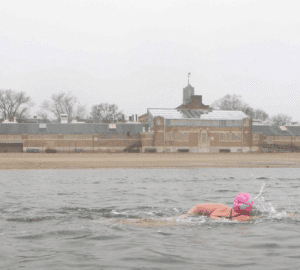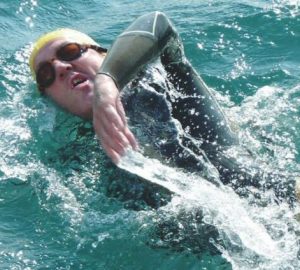Dealing with lane etiquette and lane rage
A few weeks back Pauline Squire, bravely in our opinion, posted a comment on the Outdoor Swimming Society’s Facebook page about an incident that had disturbed her training. The comments flooded in (126 the last time we looked). A couple of weeks later, Jo’ann Cheek started a new thread about lane etiquette in public sessions, which garnered another 91 comments. Then Tony Seaman posted that he’d been told he was swimming too fast, even though he was in the ‘fast’ lane. Again the responses poured in. Clearly a lot of swimmers are frustrated by the way public pools are organised and by people who don’t share the same ideas of lane etiquette. In the worst cases disagreements can turn into ugly incidents of lane rage.
What can be done?
Firstly, we should state where we stand on this. From our perspective, every pool swimmer is a potential open water swimmer, and hence a potential subscriber to H2Open, whatever speed or stroke they swim. Our sympathies lie both with the faster swimmers whose training is frustrated and slower swimmers who get bumped and swamped by people who treat a crowded lane as mass start practice.
Some comments on the subject have a somewhat elitist slant: “I’m fast, you’re slow, so you should keep out of my way.” But let’s look at it from a slightly different perspective for a moment. Just imagine you’re usually one of the fastest swimmers in your regular pool, happily ploughing up and down the fast freestyle-only lane. One day, Thomas Lurz and Spyros Gianniotis pop in for some extra training. What are you going to do? Stop every other length to let them past as they lap you or jump into the slow lane and do battle with the breaststrokers?
At a different level, this is a problem faced by many swimmers: they’re not able to keep up with the fastest people in pool but they’re too fast for the slow lane. As one exasperated swimmer said the other day, “why can’t they put in a medium lane?” And even if there is a medium lane, shouldn’t there also be a fast-medium and a slow-medium? (Or as Andrew Heather put it on Facebook, a “slow but macho” lane for the men who can’t cope with faster swimming women). But then where would you put the double lane for those who want to swim side by side and chat, or do some aqua jogging or whatever else people do in pools?
We know from discussions with pool staff that they receive plenty of complaints about fast swimmers, especially from those who have swum in the same lane for years and resent the intrusions. They say things like, “who do these fast swimmers think they are, taking over the lane like that? They act as if they own the place.” Or, “why can’t they wait until they get to the end of the lane before they overtake,” and “shouldn’t they be swimming with a club rather than in a public session?”
Pool managers also say that whatever they do, they receive complaints, especially if they make changes. Better maybe to leave things as they are for a quieter life.
Part of the problem is that the definition of ‘fast’, ‘medium’ and ‘slow’ changes with who’s in the water. One pool we know experimented with defining paces for various lanes: e.g. people in the fast lane should be swimming at 1’30” per 100m or faster. It didn’t work. If the pace was set too fast the lane would rarely be used (or the sign would be ignored); too slow and the problem of fast and slow swimmers sharing lane space would still be there. Besides, a lot of swimmers neither know nor care how fast they swim.
In some cases, life guards and pool managers could do more: pool managers by defining what the rules are for each lane, and life guards by enforcing those rules. Self regulation works some of the time but internet chatter shows that it often fails. On the other hand, it can’t always be easy for life guards to tell people to change lanes – they might well end up with more complaints or worse. Other pools and lifeguards do a better job. We’ve seen lifeguards changing lane designations, adding additional training lanes or having a quiet word with certain swimmers in order to keep things smooth.
If pools can’t or won’t do what’s necessary then swimmers need to deal with situations as they arise. Faster and more experienced swimmers could try to show more sympathy and understanding. It’s difficult, we know – but not everyone using a pool has swum in a club environment and understands rules others take for granted such as don’t push off in front of a faster swimmer or that when someone taps you on the foot they are gently letting you know they are there so you can let them pass, rather than attacking you. Trying to explain these things while you’re enraged just ain’t gonna work and will only create resentment. A smile and apology is often much more effective at clearing a lane. Remember also that experienced swimmers tend to (but don’t always) have a better sense of where they are in the lane, where everyone else is and how fast they’re all moving and can therefore accommodate lane sharing better.
We don’t know the solution. We don’t necessarily agree with the suggestion sometimes put forward to switch to drills or a kick set if you’re caught in a lane with slow swimmers. It might work sometimes or if the lane is unexpectedly or unusually crowded but longer term you want to make sure your training includes regular spells of proper swimming. Praise life guards and pool managers when they do things well, calmly explain the situation when they don’t. Invite the other swimmers in your lane to join your training sets. You might make new friends or win open water converts. If they don’t want to swim with you explain what you’re doing – interval training sets can look perplexing to people who have only ever swum continuously at one pace. Try to find friends of a similar standard to train with – the more of you in the lane the easier it will be to make your case. Mostly though, try not to let lane rage ruin your day.
We’d love to hear more suggestions from swimmers of all abilities and from anyone who works (or has worked) in pool management or as a pool life guard.







